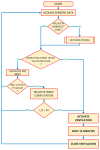An Improvement Strategy for Indoor Air Quality Monitoring Systems
- PMID: 37112335
- PMCID: PMC10145386
- DOI: 10.3390/s23083999
An Improvement Strategy for Indoor Air Quality Monitoring Systems
Abstract
Air quality has a huge impact on the comfort and healthiness of various environments. According to the World Health Organization, people who are exposed to chemical, biological and/or physical agents in buildings with low air quality and poor ventilation are more prone to be affected by psycho-physical discomfort, respiratory tract and central nervous system diseases. Moreover, in recent years, the time spent indoors has increased by around 90%. If we consider that respiratory diseases are mainly transmitted from human to human through close contact, airborne respiratory droplets and contaminated surfaces, and that there is a strict relationship between air pollution and the spread of the diseases, it becomes even more necessary to monitor and control these environmental conditions. This situation has inevitably led us to consider renovating buildings with the aim of improving both the well-being of the occupants (safety, ventilation, heating) and the energy efficiency, including monitoring the internal comfort using sensors and the IoT. These two objectives often require opposite approaches and strategies. This paper aims to investigate indoor monitoring systems to increase the quality of life of occupants, proposing an innovative approach consisting of the definition of new indices that consider both the concentration of the pollutants and the exposure time. Furthermore, the reliability of the proposed method was enforced using proper decision-making algorithms, which allows one to consider measurement uncertainty during decisions. Such an approach allows for greater control over the potentially harmful conditions and to find a good trade-off between well-being and the energy efficiency objectives.
Keywords: IAQ; IoT; air quality; decision making; monitoring systems; sensing.
Conflict of interest statement
The authors declare no conflict of interest.
Figures










Similar articles
-
A real-time monitoring and assessment method for calculation of total amounts of indoor air pollutants emitted in subway stations.J Air Waste Manag Assoc. 2012 May;62(5):517-26. doi: 10.1080/10962247.2012.660558. J Air Waste Manag Assoc. 2012. PMID: 22696802
-
Investigation of Indoor Air Quality in Residential Buildings by Measuring CO2 Concentration and a Questionnaire Survey.Sensors (Basel). 2022 Sep 27;22(19):7331. doi: 10.3390/s22197331. Sensors (Basel). 2022. PMID: 36236425 Free PMC article.
-
Real-time sensors for indoor air monitoring and challenges ahead in deploying them to urban buildings.Sci Total Environ. 2016 Aug 1;560-561:150-9. doi: 10.1016/j.scitotenv.2016.04.032. Epub 2016 Apr 18. Sci Total Environ. 2016. PMID: 27101450 Review.
-
Evaluating machine learning models to classify occupants' perceptions of their indoor environment and sleep quality from indoor air quality.J Air Waste Manag Assoc. 2022 Dec;72(12):1381-1397. doi: 10.1080/10962247.2022.2105439. Epub 2022 Oct 21. J Air Waste Manag Assoc. 2022. PMID: 35939653
-
Technology review: prototyping platforms for monitoring ambient conditions.Int J Environ Health Res. 2018 Jun;28(3):253-279. doi: 10.1080/09603123.2018.1468423. Epub 2018 May 8. Int J Environ Health Res. 2018. PMID: 29737193 Review.
Cited by
-
An IoT-Enabled E-Nose for Remote Detection and Monitoring of Airborne Pollution Hazards Using LoRa Network Protocol.Sensors (Basel). 2023 May 19;23(10):4885. doi: 10.3390/s23104885. Sensors (Basel). 2023. PMID: 37430799 Free PMC article.
-
Optimizing Winter Air Quality in Pig-Fattening Houses: A Plasma Deodorization Approach.Sensors (Basel). 2024 Jan 5;24(2):324. doi: 10.3390/s24020324. Sensors (Basel). 2024. PMID: 38257419 Free PMC article.
-
Prototype of Monitoring Transportation Pollution Spikes through the Internet of Things Edge Networks.Sensors (Basel). 2023 Nov 3;23(21):8941. doi: 10.3390/s23218941. Sensors (Basel). 2023. PMID: 37960640 Free PMC article.
References
-
- Palco V., Fulco G., De Capua CRuffa F., Lugara M. IoT and IAQ monitoring systems for healthiness of dwelling; Proceedings of the 2022 IEEE International Workshop on Metrology for Living Environment, MetroLivEn 2022—Proceedings; Cosenza, Italy. 25–27 May 2022; pp. 105–109. - DOI
-
- Fulco G., Ruffa F., Lugarà M., Filianoti P., De Capua C. Automatic station for monitoring a microgrid; Proceedings of the 24th IMEKO TC4 International Symposium and 22nd International Workshop on ADC and DAC Modelling and Testing; Palermo, Italy. 14–16 September 2022; pp. 309–314.
-
- Kwok A.G., Rajkovich N.B. Addressing climate change in comfort standards. Build. Environ. 2010;45:18–22. doi: 10.1016/j.buildenv.2009.02.005. - DOI
-
- De Capua A. Legislazione Tecnica 1 Edizione. Legislazione Tecnica; Roma, Italy: Oct, 2019. La qualità ambientale indoor nella riqualificazione edilizia.
-
- Fulco G., Palco V. Design in the Digital Age. Technology, Nature, Culture. Maggioli Editore; Emilia-Romagna, Italy: 2022. Sensoring e Iot: Abitare Smart.
MeSH terms
Substances
LinkOut - more resources
Full Text Sources
Medical

